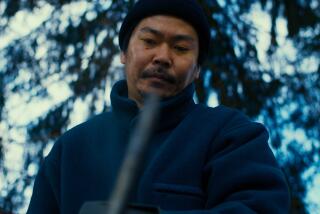MOVIE REVIEW : Silence Speaks Eloquently in ‘To Sleep So As to Dream’
- Share via
Kaizo Hayashi’s “To Sleep So As to Dream,” which screens Sunday at 7 p.m. at LACMA as part of Japan Week L.A., is pure enchantment, a tribute to the beauty and power of the silent cinema that is as knowing as it is affectionate. Except for sound effects, snatches of music and some ominous tape-recorded messages it is silent itself.
An elderly lady, Madame Cherry Blossom (Fujiko Fukamizu), whom we learn was a silent actress, is watching in her home a 50-year-old serial -- in which she was the heroine -- called Princess Bellflower. Just as the masked samurai hero is to reveal his identity the film breaks. Her butler (Yoshio Yoshida)--and onetime director--hires a pair of naive young detectives (Shiro Sano, Koji Otake), saying that Bellflower has been kidnaped by M. Pathe & Co.
Their investigation takes them to such quaint locales as the General Jintan Tower, the Flower Star Wheel and eventually the Electric House, an Asakusa movie theater, where Pathe just happens to be presenting Madame Cherry Blossom’s serial, “The Eternal Mystery.” “To Sleep So As to Dream” is set in the late ‘50s--when, incidentally, Hayashi, was born; how the Electric Dream happens to be still operating can be chalked up to the movie magic that blurs fantasy and reality and which its writer-director celebrates with such imagination and precision.
Madame Cherry Blossom proves to be a benign Norma Desmond whose own devoted Max Von Mayerling wants to help recapture her youth in the most innocent and loving way possible. “To Sleep” is at its most touching when expressing the silent cinema’s unique potential for pathos. On another level, Hayashi is having some gentle fun with early detective serials of the kind pioneered and epitomized by Louis Feuillade’s fantastic “Fantomas” and “Judex.”
As for why Hayashi, who will introduce “To Sleep So As to Dream” (Times-rated Family), chose to make his 1986 feature debut with such a film, he has said that “This is the origin of the motion picture; there is a sobriety (to black-and-white silent cinema) which refuses anything which is not enjoyable.”
Also screening (at 7:30 p.m. at the Pacific Design Center Theater) as part of Japan Week L.A. are “The Discarnates” (Monday) and “Buddies” (Tuesday). Nobuhiko Obayashi’s “The Discarnates” connects with our deepest longings in a remarkably potent fashion. Who, after all, has not yearned for reunion with long-gone loved ones? Not only does Obayashi and his writers make such an encounter convincing but also give it a larger purpose; the result is a graceful, heart-tugging fantasy of the supernatural. The film’s hero (Morio Kazama) is a dapper, 40-year-old writer of TV soap operas; like the detectives in “To Sleep” he too encounters the past in an old Asakusa theater.
Shown recently at the Little Tokyo Cinemas, Yasuo Furuhata’s “Buddies” exudes such a warm, sentimental glow that it’s easy to overlook its subtlety and complexity, both as a consideration of the sometimes thorny nature of friendship, and beyond this, the treacherousness of nostalgia. The time is the spring of 1937, just before the Rape of Nanking, a prelude to wartime madness. Ken Takakura is wonderful as an industrialist who has an unrequited love for the beautiful wife (Sumiko Fuji) of an oafish office worker, his army buddy.
Admission is free but reservations are required: (213) 627-6217.
More to Read
Only good movies
Get the Indie Focus newsletter, Mark Olsen's weekly guide to the world of cinema.
You may occasionally receive promotional content from the Los Angeles Times.










